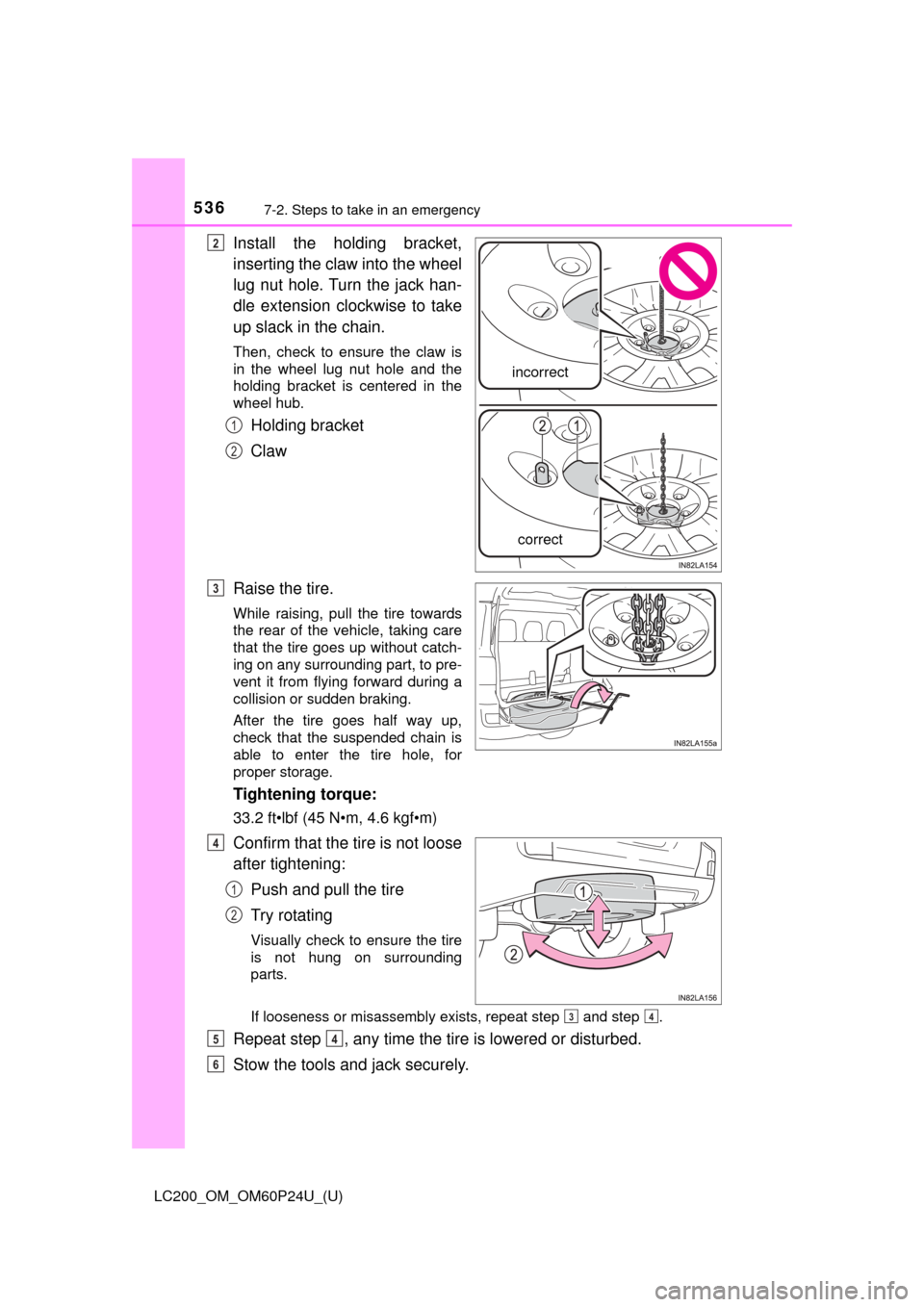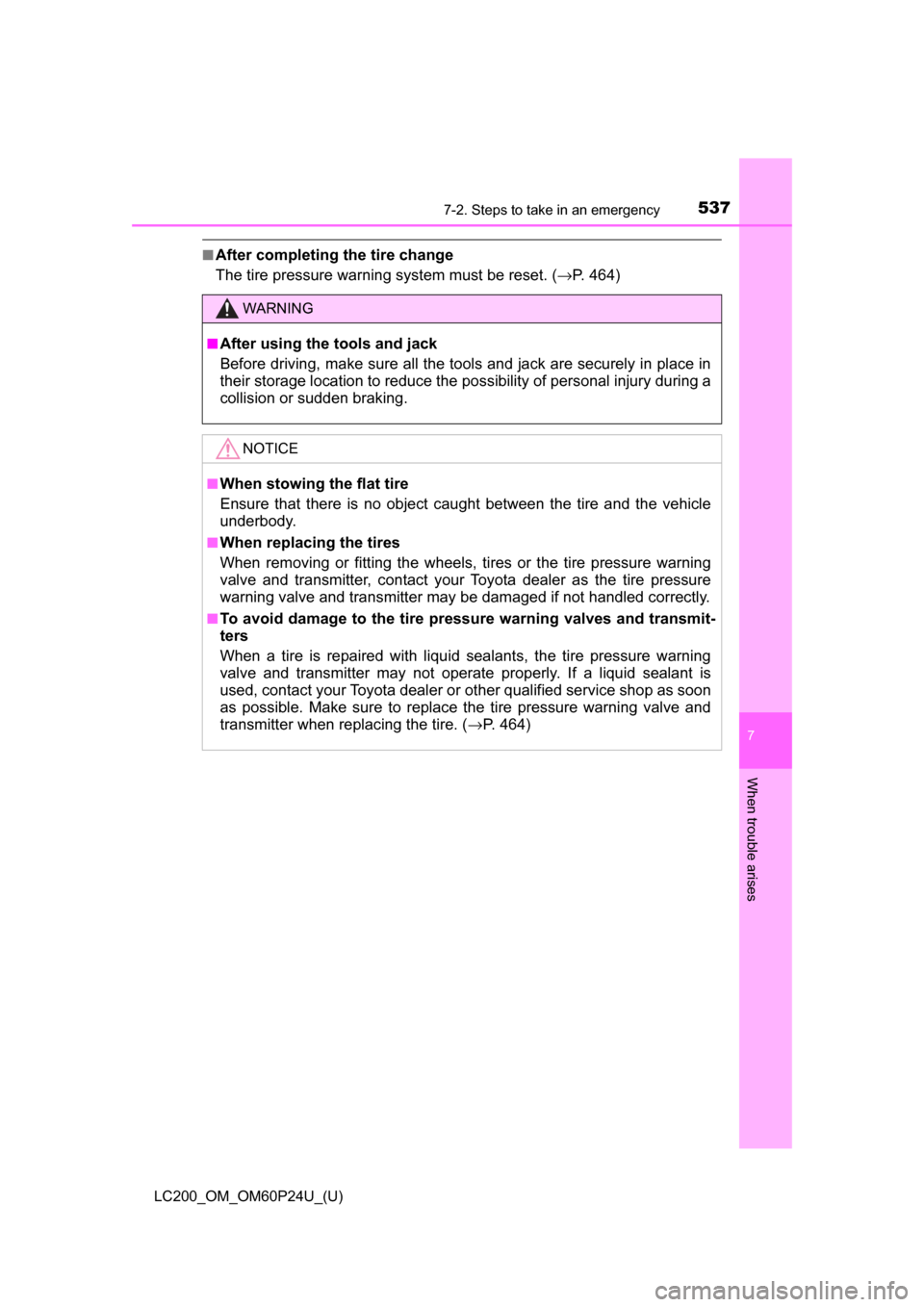Page 503 of 608
5037-2. Steps to take in an emergency
LC200_OM_OM60P24U_(U)
7
When trouble arises
Do not tow with a sling-type truck
to prevent body damage.
Towing with a sling-type truck
Towing with a wheel-lift type truck
From the frontFrom the rear
Use a towing dolly under the rear
wheels. Use a towing dolly under the
front wheels.
Page 504 of 608
5047-2. Steps to take in an emergency
LC200_OM_OM60P24U_(U)
If your vehicle is transported by a
flatbed truck, it should be tied
down at the locations shown in the
illustration.
If you use chains or cables to tie
down your vehicle, the angles
shaded in black must be 45°.
Do not overly tighten the tie
downs or the vehicle may be dam-
aged.
If a tow truck is not available in an emergency, your vehicle may be
temporarily towed using cables or chains secured to the emergency
towing hooks. This should only be attempted on hard surfaced roads
for at most 50 miles (80 km) at under 18 mph (30 km/h).
A driver must be in the vehicle to steer and operate the brakes. The
vehicle’s wheels, drive train, axles, steering and brakes must be in
good condition.
Using a flatbed truck
Emergency towing
Page 505 of 608
5057-2. Steps to take in an emergency
LC200_OM_OM60P24U_(U)
7
When trouble arises
Securely attach cables or
chains to the towing hooks.
Take care not to damage the vehi-
cle body.
Enter the vehicle being towed and start the engine.
If the engine does not start, turn the engine switch to IGNITION ON
mode.
Put the four-wheel drive control switch in “H4”. (The center differen-
tial is unlocked.)
Shift the shift lever to N and release the parking brake.
When the shift lever cannot be shifted: →P. 2 0 3
■While towing
If the engine is not running, the power assist for the brakes and steering will
not function, making steering and braking more difficult.
Emergency towing procedure
1
2
3
4
Page 506 of 608
5067-2. Steps to take in an emergency
LC200_OM_OM60P24U_(U)
WARNING
Observe the following precautions.
Failure to do so may result in death or serious injury.
■When towing the vehicle
■ While towing
● When towing using cables or chains, avoid sudden starts, etc. which place
excessive stress on the towing hooks, cables or chains. The towing hooks,
cables or chains may become damaged, broken debris may hit people and
cause serious damage.
● Do not turn the engine switch off.
There is a possibility that the steering wheel is locked and cannot be oper-
ated.
Be sure to transport the vehicle with all
four wheels raised off the ground. If the
vehicle is towed with the tires contacting
the ground, the drivetrain or related parts
may be damaged, the vehicle may fly off
the truck.
Page 507 of 608
5077-2. Steps to take in an emergency
LC200_OM_OM60P24U_(U)
7
When trouble arises
NOTICE
■To prevent damage to the vehicle wh en towing using a wheel-lift type
truck
● Do not tow the vehicle from the rear when the engine switch is off. The
steering lock mechanism is not strong enough to hold the front wheels
straight.
● When raising the vehicle, ensure adequate ground clearance for towing at
the opposite end of the raised vehicle. Without adequate clearance, the
vehicle could be damaged while being towed.
■ To prevent damage to the vehicle wh en towing with a sling-type truck
Do not tow with a sling-type truck, either from the front or rear.
■ To prevent damage to the vehic le during emergency towing
Do not secure cables or chains to the suspension components.
■ To avoid serious damage to your vehicle
Do not use the rear emergency towing
hook.
Page 535 of 608
5357-2. Steps to take in an emergency
LC200_OM_OM60P24U_(U)
7
When trouble arises
Reinstall the wheel ornament.
Remove the center wheel orna-
ment from the flat tire by pushing
from the reverse side, and rein-
stall it.
Lay down the tire with the valve
stem facing up, and install the
spare wheel cover.
5
WARNING
■
Stowing the flat tire
Failure to follow steps listed under st owing the tire may result in damage
to the spare tire carrier and loss of the tire, which could result in death or
serious injury.
Stowing the flat/spare tire, jack and tools
1
Page 536 of 608

5367-2. Steps to take in an emergency
LC200_OM_OM60P24U_(U)
Install the holding bracket,
inserting the claw into the wheel
lug nut hole. Turn the jack han-
dle extension clockwise to take
up slack in the chain.
Then, check to ensure the claw is
in the wheel lug nut hole and the
holding bracket is centered in the
wheel hub.
Holding bracket
Claw
Raise the tire.
While raising, pull the tire towards
the rear of the vehicle, taking care
that the tire goes up without catch-
ing on any surrounding part, to pre-
vent it from flying forward during a
collision or sudden braking.
After the tire goes half way up,
check that the suspended chain is
able to enter the tire hole, for
proper storage.
Tightening torque:
33.2 ft•lbf (45 N•m, 4.6 kgf•m)
Confirm that the tire is not loose
after tightening: Push and pull the tire
Try rotating
Visually check to ensure the tire
is not hung on surrounding
parts.
If looseness or misassembly exists, repeat step and step .
Repeat step , any time the ti re is lowered or disturbed.
Stow the tools and jack securely.
incorrect
correct
2
1
2
3
4
1
2
34
54
6
Page 537 of 608

5377-2. Steps to take in an emergency
LC200_OM_OM60P24U_(U)
7
When trouble arises
■After completing the tire change
The tire pressure warning system must be reset. ( →P. 464)
WARNING
■
After using the tools and jack
Before driving, make sure all the tools and jack are securely in place in
their storage location to reduce the po ssibility of personal injury during a
collision or sudden braking.
NOTICE
■When stowing the flat tire
Ensure that there is no object cau ght between the tire and the vehicle
underbody.
■When replacing the tires
When removing or fitting the wheels, tires or the tire pressure warning
valve and transmitter, contact your Toyota dealer as the tire pressure
warning valve and transmitter may be damaged if not handled correctly.
■To avoid damage to the tire pressure warning valves and transmit-
ters
When a tire is repaired with liquid sealants, the tire pressure warning
valve and transmitter may not operate properly. If a liquid sealant is
used, contact your Toyota dealer or other qualified service shop as soon
as possible. Make sure to replace the tire pressure warning valve and
transmitter when replacing the tire. ( →P. 464)